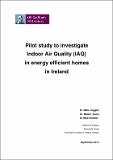Pilot study to investigate indoor air quality (IAQ) in energy efficient homes in Ireland: Report prepared for EPA STRIVE and Sustainable Energy Authority of Ireland
Date
2010-09Author
Coggins, Marie
Byrne, Miriam
Kleefeld, Silke
Metadata
Show full item recordUsage
This item's downloads: 393 (view details)
Recommended Citation
Coggins, Marie, Byrne, Miriam, & Kleefeld, Silke. (2010). Pilot study to investigate indoor air quality (IAQ) in energy efficient homes in Ireland: Report prepared for EPA STRIVE and Sustainable Energy Authority of Ireland: School of Physics, NUI Galway.
Published Version
Abstract
Within this pilot study a number of Indoor air pollutants were measured in five energy efficient
homes built to enhanced standards of air tightness of between 0.75 m3
/hr/m2
and 8.75 m3
/hr/m2
.
The five homes were built according to the requirements of the 2007 Building Regulations. The
objective was to evaluate whether increased standards of air tightness impacts on the indoor air
quality and thermal comfort the home. The selected homes were a mixture of 3- and 4-bedroom
semi-detached houses, and were occupied. Two of the houses had mechanical ventilation with
heat recovery (MVHR) system, while the other three houses used natural ventilation.
Indoor air quality measurements of selected pollutants, i.e. particulates (PM2.5, PM10) , nitrogen
dioxide, formaldehyde, total volatile organic carbon, carbon monoxide and dust mite concentrations,
and thermal comfort parameters, i.e. temperature and relative humidity, were carried out over
sampling periods of 24 hours, 7 days and 14 days, respectively. In addition, air exchange rates of
selected rooms within each individual home were established. Diary records of occupant activities
and household questionnaires on the homes and their indoor environment were also collected.
In general the levels of pollutants measured in this project were within recommended guideline
limits. Variations in pollutant concentrations could in most cases, be correlated to certain activities
within the individual homes, like for example cooking, smoking, or redecorating. However as this
was a small scale project it is difficult to draw definitive conclusions regarding the impact of
increased air tightness on indoor air quality and thermal comfort. A larger scale study, building on
the findings of this pilot project, is recommended. There is a lack of data internationally on indoor
air quality in highly energy efficient homes. A larger scale project should include a broader range of
building types such as detached or terraced houses and apartments etc. and should also include a
larger number of homes which use energy saving technologies such as MHVR. This study would
also look at how indoor air concentrations vary by season, it is likely that higher concentrations
maybe found in the winter period, during periods of maximum fuel use and maximum occupancy. A
larger study would also include a qualitative element such as a National survey, of key stakeholders
working in this area. The aim of the survey would be to collect information on the le vel of
knowledge, the usability and suitability of the energy technologies available to home owners today.
Experiences gained in this project, seemed to suggest that there is a lack of knowledge among some
members of public on what energy efficient technologies are available and it was difficult to find 3
or 4 bed semi detached homes who were using energy saving technologies to participate in this
pilot study.


